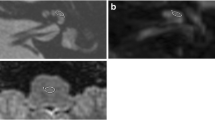Abstract
The aim of this multicentre study was to compare T1 with T2 weighted MRI scans of the labyrinth after meningitis and to investigate whether waiting with scanning improved the reliability of diagnosing an ongoing process such as cochlear osteogenesis. Forty-five patients were included who suffered from meningitis induced hearing loss (radiological imaging <1 year after meningitis). Twenty-one gadolinium enhanced T1 and 45 T2 weighted MRI scans were scored by two radiologists regarding the condition of the labyrinth. These radiological observations were compared with the condition of the cochlea as described during cochlear implantation. A higher percentage of agreement with surgery was found for T2 (both radiologists 73%) than for T1 weighted MRI scans (radiologist 1: 62%, radiologist 2: 67%), but this difference is not significant. There was no significant difference between early (0–3 months) and late (>3 months) scanning, showing that radiological imaging soon after meningitis allows early diagnosis without suffering from a lower agreement with surgical findings.




Similar content being viewed by others
References
Fortnum HM (1992) Hearing impairment after bacterial meningitis: a review. Arch Dis Child 67(9):1128–1133
Dodge PR, Davis H, Feigin RD, Holmes SJ, Kaplan SL, Jubelirer DP, Stechenberg BW, Hirsh SK (1984) Prospective evaluation of hearing impairment as a sequela of acute bacterial meningitis. N Engl J Med 311(14):869–874
Kutz JW, Simon LM, Chennupati SK, Giannoni CM, Manolidis S (2006) Clinical predictors for hearing loss in children with bacterial meningitis. Arch Otolaryngol Head Neck Surg 132(9):941–945
Merchant SN, Gopen Q (1996) A human temporal bone study of acute bacterial meningogenic labyrinthitis. Am J Otol 17(3):375–385
Kesser BW, Hashisaki GT, Spindel JH, Ruth RA, Scheld WM (1999) Time course of hearing loss in an animal model of pneumococcal meningitis. Otolaryngol Head Neck Surg 120(5):628–637
Rotteveel LJ, Snik AF, Vermeulen AM, Mylanus EA (2005) Three-year follow-up of children with postmeningitic deafness and partial cochlear implant insertion. Clin Otolaryngol 30(3):242–248
Eisenberg LS, Luxford WM, Becker TS, House WF (1984) Electrical stimulation of the auditory system in children deafened by meningitis. Otolaryngol Head Neck Surg 92(6):700–705
Axon PR, Temple RH, Saeed SR, Ramsden RT (1998) Cochlear ossification after meningitis. Am J Otol 19(6):724–729
Nabili V, Brodie HA, Neverov NI, Tinling SP (1999) Chronology of labyrinthitis ossificans induced by Streptococcus pneumoniae meningitis. Laryngoscope 109(6):931–935
Brodie HA, Thompson TC, Vassilian L, Lee BN (1998) Induction of labyrinthitis ossificans after pneumococcal meningitis: an animal model. Otolaryngol Head Neck Surg 118(1):15–21
Laszig R, Chang SO, Kubo T, Ramos MA, Frijns JH, Briggs R, Haynes DS (2007) APSCI panel discussion I: imaging and surgical issues. Ear Hear 28(2):119S–123S
Offeciers E, Morera C, Muller J, Huarte A, Shallop J, Cavalle L (2005) International consensus on bilateral cochlear implants and bimodal stimulation. Acta Otolaryngol 125(9):918–919
Durisin M, Arnoldner C, Stover T et al (2008) Audiological performance in cochlear implanted patients deafened by meningitis depending on duration of deafness. Eur.Arch.Otorhinolaryngol 265:381–388
Gleeson TG, Lacy PD, Bresnihan M, Gaffney R, Brennan P, Viani L (2003) High resolution computed tomography and magnetic resonance imaging in the pre-operative assessment of cochlear implant patients. J Laryngol Otol 117(9):692–695
Bettman R, Beek E, Van Olphen A, Zonneveld F, Huizing E (2004) MRI versus CT in assessment of cochlear patency in cochlear implant candidates. Acta Otolaryngol 124(5):577–581
Aschendorff A, Klenzner T, Laszig R (2005) Deafness after bacterial meningitis: an emergency for early imaging and cochlear implant surgery. Otolaryngol Head Neck Surg 133(6):995–996
Parry DA, Booth T, Roland PS (2005) Advantages of magnetic resonance imaging over computed tomography in preoperative evaluation of pediatric cochlear implant candidates. Otol Neurotol 26(5):976–982
Dahm MC, Mack MG, Tykocinski M, Vogl TJ (1997) Submillimeter imaging and reconstruction of the inner ear. Am J Otol 18(6 Suppl):S54–S56
Seitz J, Held P, Waldeck A, Strotzer M, Volk M, Strutz J, Feuerbach S (2001) Value of high-resolution MR in patients scheduled for cochlear implantation. Acta Radiol 42(6):568–573
Valvassori GE (1993) Imaging of otosclerosis. Otolaryngol Clin North Am 26(3):359–371
Ziyeh S, Berlis A, Ross UH, Reinhardt MJ, Schumacher M (1997) MRI of active otosclerosis. Neuroradiology 39(6):453–457
Chan CC, Saunders DE, Chong WK, Hartley BE, Raglan E, Rajput K (2007) Advancement in post-meningitic lateral semicircular canal labyrinthitis ossificans. J Laryngol Otol 121(2):105–109
Lin SP, Brown JJ (2007) MR contrast agents: physical and pharmacologic basics. J Magn Reson Imaging 25(5):884–899
Acknowledgment
The authors would like to thank Mr. M. Durisin of the Medical University of Hannover for his effort in collecting the data and Mr T. De Boo of the epidemiological department of the University Medical Centre Nijmegen for his advice and support with the statistical analysis.
Conflict of interest statement
None of the authors had any financial interest in the current research. There was no conflict of interest for any of the authors.
Open Access
This article is distributed under the terms of the Creative Commons Attribution Noncommercial License which permits any noncommercial use, distribution, and reproduction in any medium, provided the original author(s) and source are credited.
Author information
Authors and Affiliations
Corresponding author
Additional information
An erratum to this article can be found at http://dx.doi.org/10.1007/s00405-009-0977-9
Rights and permissions
About this article
Cite this article
Beijen, J., Casselman, J., Joosten, F. et al. Magnetic resonance imaging in patients with meningitis induced hearing loss. Eur Arch Otorhinolaryngol 266, 1229–1236 (2009). https://doi.org/10.1007/s00405-009-0921-z
Received:
Accepted:
Published:
Issue Date:
DOI: https://doi.org/10.1007/s00405-009-0921-z




